Key Points:
- Cheetahs are a rare find on safari excursions, as they are most active after sunset. They are solitary creatures that spend their days resting to avoid the intense heat of their habitat.
- Most people think zebras have white and black stripes. Actually, they have black skin with white fur stripes running across it.
- Baboons, who travel in troops, live in savannas, semi-arid regions, and tropical forests in Africa. Their diet consists of fruits, plants, and small animals.
African safaris are spectacular and can be downright life-changing. For the best experiences, travelers typically head to Botswana, Kenya, Mozambique, Zambia, South Africa, Namibia, Uganda, Tanzania, and Rwanda. But what are the must-see animals when you’re on safari in these magical countries? Opinions vary. Some people only care about “the big five.” Others focus on avifauna. Our animal experts split the difference and came up with a top 10 safari animals list. So, without further ado, let’s dive in!
#10 Safari Animals You MUST See: Masai Ostrich
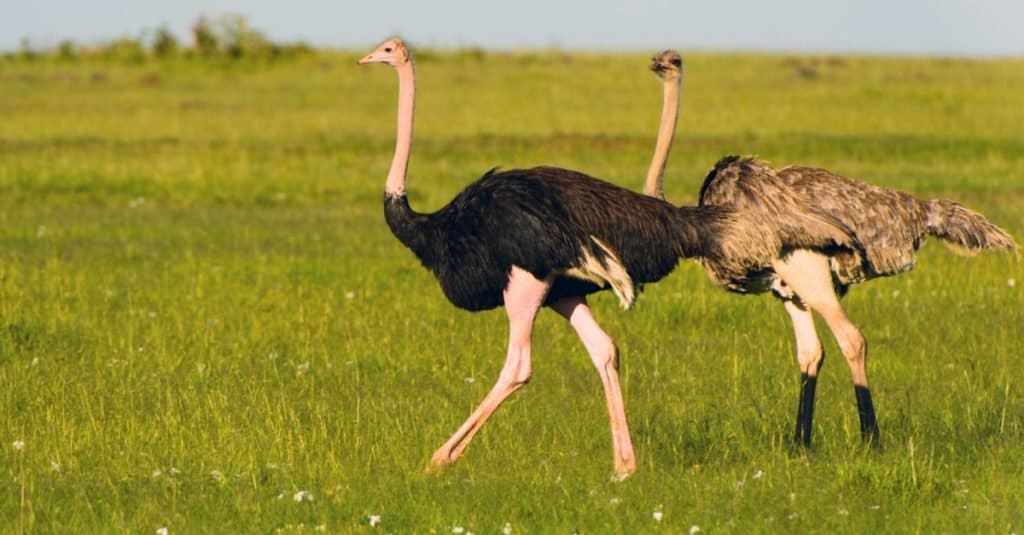
©Cristian Zamfir/Shutterstock.com
The flightless Masai ostrich is a thrill to see on safari. Individuals stand between eight and nine feet tall and tip the scales at 320 pounds! And although they cannot fly the friendly skies, Masai ostriches are quicksilver sprinters that reach speeds of up to 44 miles per hour, which is fast for a giant bird!
Masai ostriches have the largest eggs of any living avian species, and they practice communal nesting. All expectant parents deposit their eggs in a giant nest minded by the population’s dominant female. She doesn’t have an easy job because jackals, hyenas, and birds of prey love ostrich eggs. But they have help. Males do their best to protect the nests and their respective territories. Over centuries, they even learned to mimic lion roars to scare away prowling predators.
Though the IUCN currently classifies the species as Least Concern, seeing Masai ostriches on safari is becoming less common because their numbers are declining. Human encroachment is the main culprit.
Click here to learn about ostriches, which have very strong legs!
#9 Safari Animals You MUST See: Cheetah
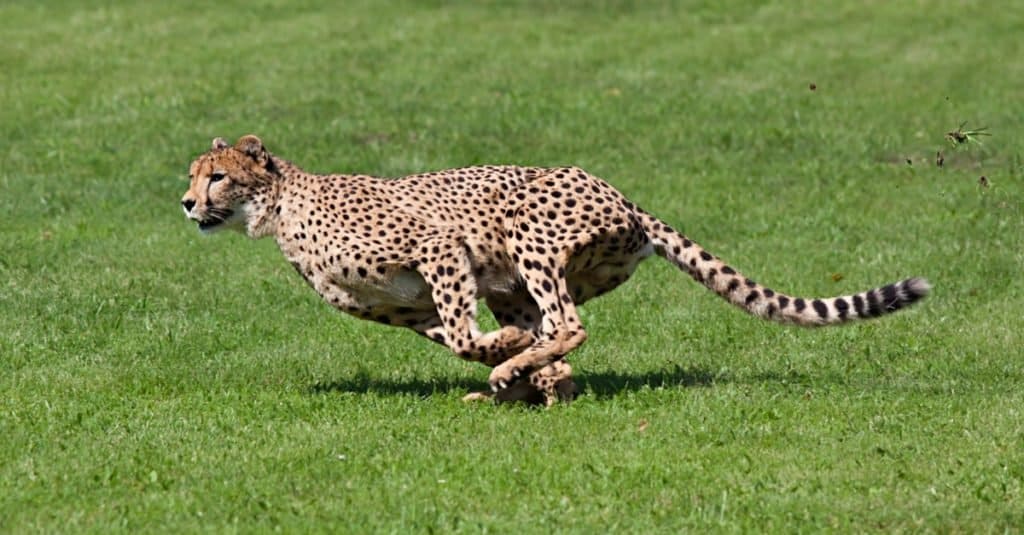
©Maros Bauer/Shutterstock.com
Many people are surprised to learn that cheetahs rank among the smaller safari animals. However, they are the fastest land animals on Earth and can reach 80 miles per hour in three seconds! Cheetahs are most often seen on Kenyan and Tanzanian safaris.
Like most large African animals, cheetahs are most active after sunset because they spend their days resting to avoid heat exhaustion. Unlike lions, cheetahs are solitary. On occasion, though, males travel together in packs called “coalitions.” The average cheetah has 2,000 to 3,000 spots and weighs between 40 and 160 pounds.
Super lucky safari participants are sometimes able to catch a cheetah hunt. Typically, they prey on impalas, gazelles, and wildebeests. Like house cats, cheetahs get much of their water from food and survive on one drink every four days.
Sadly, only 10,000 to 12,000 cheetahs remain in the wild. Loss of habitat and resource competition are to blame for their decline.
Click here to learn more about cheetahs, which once roamed throughout Europe!
#8 Safari Animals You MUST See: Lion

©Maggy Meyer/Shutterstock.com
The undisputed “king of the jungle,” lions are one of the most anticipated safari sightings. The regal golden felines have long captured the human imagination, and they’re the only big cats to live in social groups called “prides.”
Prides can be as small as two and as large as 40, but the average group numbers between 13 and 16. Like human families, prides are composed of related individuals.
Many folks are surprised to learn that females do most of the hunting. On average, lady lions kill between 15 and 20 large animals a year, and they’re significantly more successful when they group hunt. When lions aren’t feasting on a large catch, they feed on smaller animals.
Though westerners tend to see lions as ferocious and commanding, the Masai people respect the felines as shy-but-lethal neighbors. While the large cats are apex predators, they keep to themselves.
Many people enjoy spotting lion prides on safari. However, it’s becoming less common. African lions have been driven from 90 percent of their historical range, and only about 20,000 are left in the wild. Since the 1990s, populations have declined by 43 percent, putting them in the IUCN’sVulnerable category.
Click here to learn more about lions, whose roars can be heard five miles away!
#7 Safari Animals You MUST See: Zebra

©Martin Prochazkacz/Shutterstock.com
Native to Africa and cousins to horses and donkeys, zebras are iconic safari animals. The striped ungulates are herbivores and a major prey target of big cats, especially lions. But zebras don’t go down easily. They’re capable fighters, and their kicks can be lethal!
Zebras inhabit the grasslands, woodlands, shrublands, and even mountainous regions of eastern and southern Africa.
Contrary to popular belief, zebras don’t have white and black fur. Instead, they have black skin with intermittent white fur stripes. Scientists believe zebras’ unique coloration naturally protects them from biting flies.
Three zebra species live in Africa, and they’re all on the IUCN Red List. Grévy’s zebras are Endangered, mountain zebras are Vulnerable, and plains zebras are Near Threatened.
Grévy’s zebras are more solitary than the mountain and plains zebras. The former travel in loose groups of related animals while the latter two congregate in tight-knit packs known as harems. They can also be referred to as “dazzles” or “zeals” of zebras. To communicate, zebras bare their teeth, widen their eyes, and vocalize through huffing, puffing, and braying. Zebras also practice social grooming.
The luckiest safari-goers catch a glimpse of Tira, the world’s only polka-dotted zebra. She lives in Kenya’s Masai Mara National Reserve, and her appearance is a result of a genetic anomaly.
Click here to learn more about zebras, whose stripes are like human fingerprints: unique to each individual.
#6 Safari Animals You MUST See: Baboon
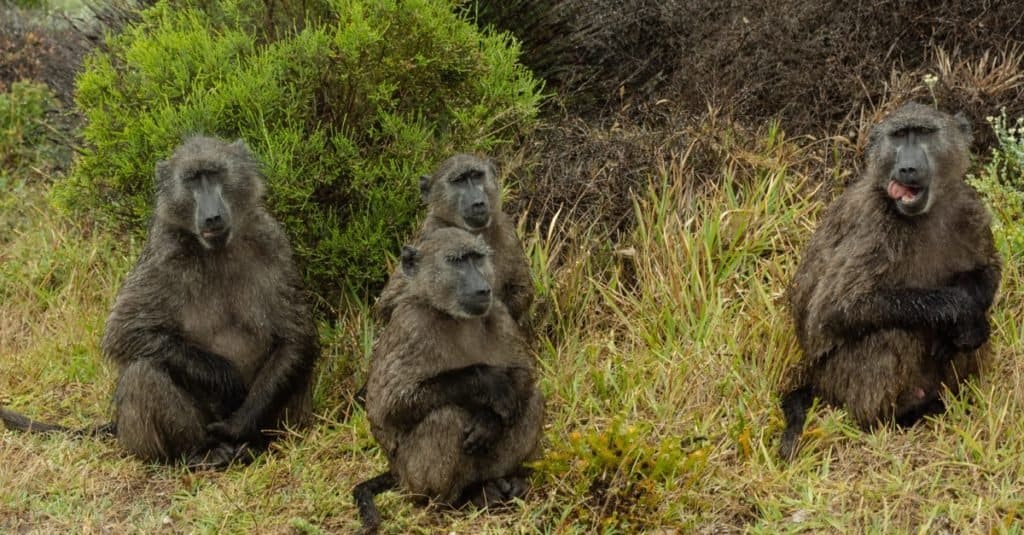
©Poony Pitchanan/Shutterstock.com
Baboons are old-world primates who’ve been around for over two million years! Five major baboon species live in the savannas, semi-arid regions, and tropical forests of Africa. Baboons travel in “troops,” and they’re omnivores who dine on fruits, plants, and small animals.
During the day, baboons eat, groom, and spend time hanging out with their families. Females handle the bulk of child care duties, and mothers help each other clean, feed, and teach the young ones. Males are typically on protection duty and on the lookout for Nile crocodiles, leopards, and hyenas. When night falls, they retire to treetops and sleep.
Baboons are very smart, evidenced by a famous one named Jack who lived with a man named James Edwin Wide, a rail signalman in South Africa with two peg legs. Every day, Jack pushed James to work in a trolley. Once the pair got to the station, Jack got to work sweeping the floors and taking out the trash. James eventually taught Jack how to switch the rails, and once he learned, the baboon never made a mistake! What did James do all day once Jack took over all the duties? Let’s just say he had a lot of free time to pursue hobbies. But James didn’t take advantage of Jack. After a departmental review of his station, James secured 20 cents per day and half a bottle of beer every week for his assistant!
Click here to learn more about baboons, which can travel more than four miles a day.
#5 Safari Animals You MUST See: African Leopard

©Michael Wick/Shutterstock.com
African leopards are the smallest big cats. They’re also solitary and only convene for mating and child-rearing. The graceful felines enjoy superior hearing and vision senses and tend to hunt at night.
Leopards are adaptation masters. Depending on their location’s camouflage needs, leopards’ colors vary from pale yellow to black. Additionally, their diets are broad. The flexible cats eat everything from dung beetles to elands. A famous study detected remnants from 92 different species in one leopard’s refuse!
Leopards can be found in a variety of habitats including tropical rainforests, tree-lined savannahs, mountain highlands, and barren deserts. While some of their habitats have shrunk due to deforestation and urban development, animals have adapted to a growing human presence in some regards, and have been known to live and hunt in urban areas.
Like too many safari animals, African leopard populations are shrinking. Overall, increased human-leopard conflict is accelerating the decline.
Click here to learn more about leopards, which spend a lot of time in trees.
#4 Safari Animals You MUST See: Cape Buffalo
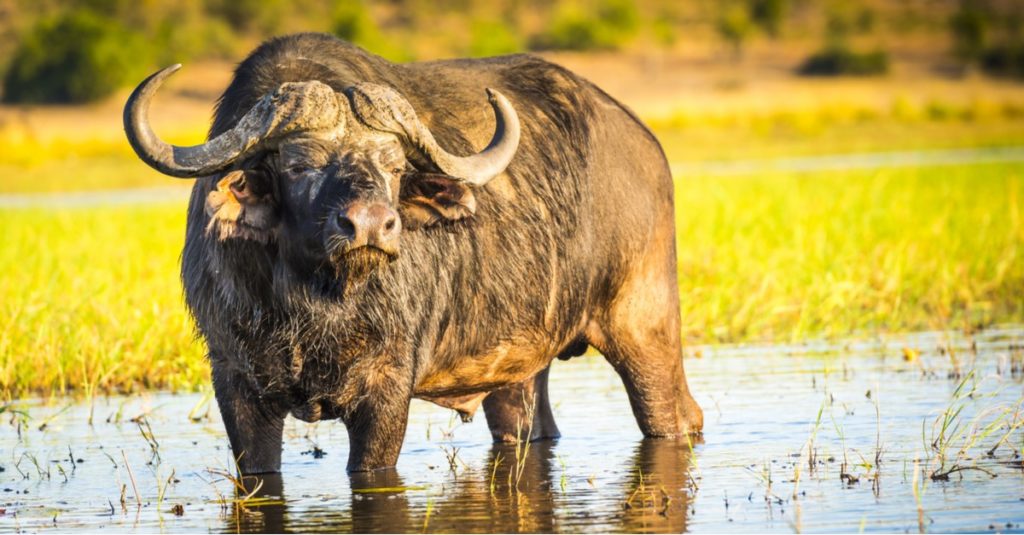
©THP Creative/Shutterstock.com
They may be herbivores, but their imposing size and unpredictability make Cape buffalo one of the more dangerous safari animals. Individuals weigh up to 1,500 pounds and charge when they feel threatened. Rhinos also believe in revenge attacks and will pursue hunters that shoot in their direction. On average, the giant cow-like animals trample between 100 and 200 people annually and have earned themselves an ominous collective nickname: “Black Death.”
Cape buffalo roll deep; some herds number in the thousands. Seeing a large group on safari can feel like a seismic experience — and if you’re lucky, you may catch a glimpse of genets hitching rides. Occasionally, Cape buffalo give the catlike animals lifts, offering up their backs as wildlife public transportation buses.
Surprisingly, Cape buffalo are strong swimmers and regularly cross large rivers in search of food.
Poachers are a lethal problem for Cape buffalo. Killed for their horns and head-bone plates, called “bosses,” they’re sought after game trophies. In addition to hunting humans, Cape buffalo naturally fall prey to lions and large crocodiles.
Click here to learn more about African buffalo, which can reach speeds of 35 miles per hour.
#3 Safari Animals You MUST See: Rhinos
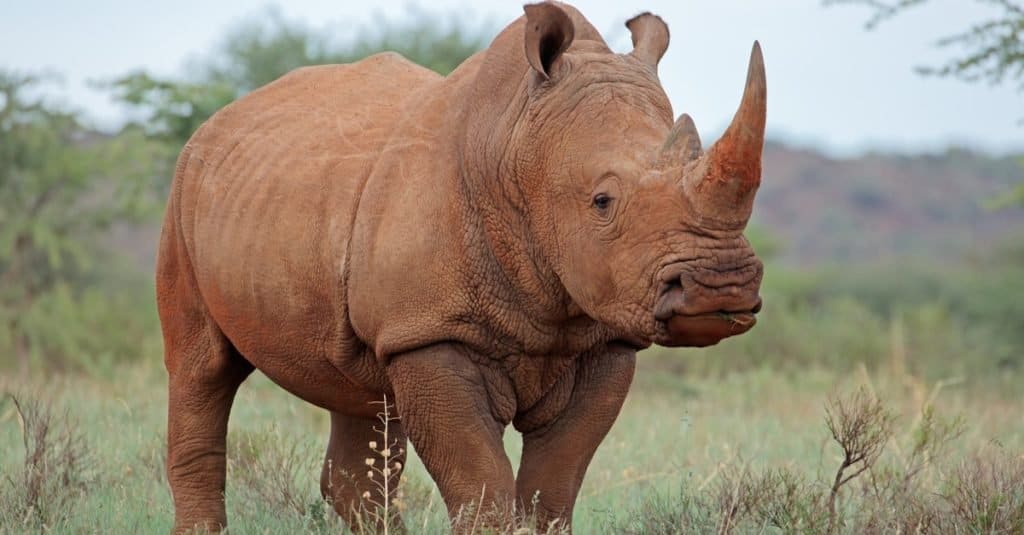
©EcoPrint/Shutterstock.com
The second-largest land mammal, rhinos are gigantic herbivores with tiny brains, bad eyesight, and no front teeth. The behemoths, however, do have excellent olfactory nerves and can “out smell” most animals.
There are five species of rhinos, and two live in Africa: white and black rhinos. White rhinos, which are actually gray, are the biggest and can weigh over 6,000 pounds.
Rhinos travel in groups called “crashes,” communicate through grunts, snorts, and honks, and they love to roll around in the mud. Not just because it’s fun, but the wet dirt cools them off, serves as an insect repellent, and scrubs their skin of unwanted parasites.
As is the case for far too many species on this safari animals list, rhinos are poaching targets. Their horns are sold on the black market and can cost as much as gold!
Click here to learn more about rhinos, whose horns are made of keratin.
#2 Safari Animals You MUST See: Waterbuck
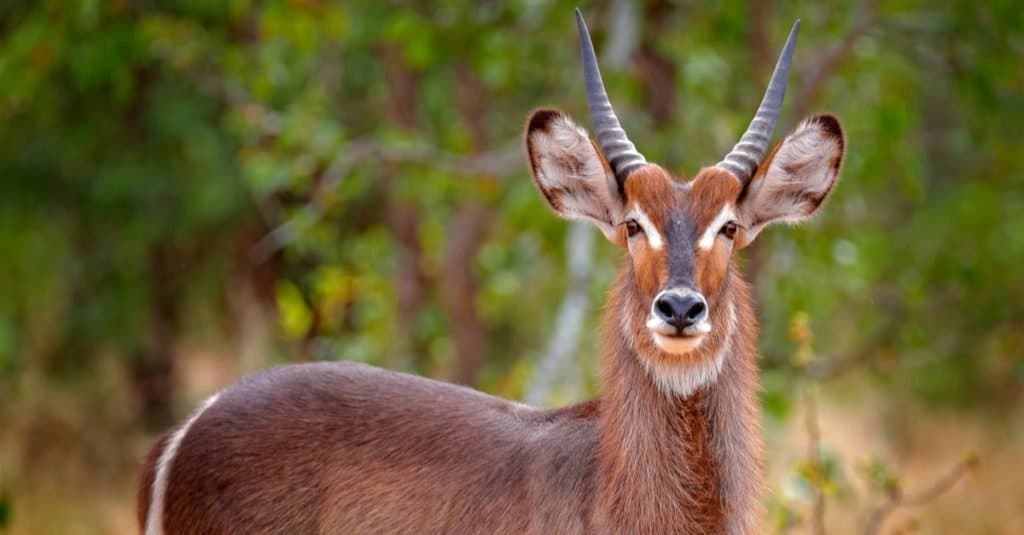
©Ondrej Prosicky/Shutterstock.com
Waterbucks are a special treat to spot in the wild. The large antelope species isn’t endangered, but individuals avoid humans. Plus, their heightened need for hydration keeps them close to lakes and rivers off the beaten path of most safaris.
Typically, waterbucks travel in groups of up to 30; however, adult males and females don’t travel together. Instead, they convene for mating and then part ways. You can easily differentiate between ladies and gents because males don massive spiraled horns that curve backward then forward.
Like many animals in the bush, waterbuck populations are declining, but they’re not yet on any endangered species lists. However, the IUCN recently classified the defassa waterbuck subspecies as Near Threatened. Poaching and human encroachment are waterbucks’ main threats.
Click here to learn more about antelopes, which renew their horns annually.
#1 Safari Animals You MUST See: African Elephant

©Volodymyr Burdiak/Shutterstock.com
Elephants are incredible, brilliant animals. The gentle giants enjoy deep familial bonds and are one of the most sensitive species on the planet. Not only do they enjoy music and communicate over long distances, but they also mourn their dead and attempt to help other elephants — and sometimes humans — who appear hurt or needy.
African elephants migrate seasonally and live in matriarchal family herds. Adult male elephants, called bulls, typically fly solo outside of mating season. However, you can sometimes stumble upon a bachelor group while on safari. Bulls usually leave their mothers’ herds between the ages of 10 and 19.
The largest land mammals, elephants can eat 300 to 400 pounds a day! But they never eat meat. Elephants are herbivores who stick to a strict diet of bamboo, grass, bark, roots, and leaves.
You can tell African elephants from other species because their ears are the shape of Africa. Their other notable feature, trunks, have up to 40,000 muscles!
Elephants are currently facing several threats. Poachers target the majestic animals for their meat and ivory, habitat loss is leading to population fragmentation, and human-elephant conflict is on the rise. Fascinatingly, some younger generations are evolving as tuskless. Scientists believe the phenomenon is a response to poaching. However, the change could have a catastrophic effect on the species because they use tusks for myriad tasks, including digging and gathering food.
Click here to learn more about African elephants, which drink up to 50 gallons of water a day!
And that’s our safari animals list. Do you agree with our picks? Reach out and let us know if you’d like to see a particular animal added!
Summary of the 10 Safari Animals You MUST See
| Rank | Animal |
|---|---|
| 1 | African Elephant |
| 2 | Waterbuck |
| 3 | Rhinoceros |
| 4 | Cape Buffalo |
| 5 | African Leopard |
| 6 | Baboon |
| 7 | Zebra |
| 8 | Lion |
| 9 | Cheetah |
| 10 | Masai Ostrich |
Up Next…
- The World’s Top 10 Non-Traditional Pets! Not satisfied with the idea of a classic cat or dog for a pet? Then check out these top 10 non-traditional pets for ideas.
- Types of Elephants: The 3 Species of Elephants Learn more about the 3 species of elephants that inhabit our planet in this interesting article.
- The 10 Fastest Animals In North America There’s some really fast animals in North America. Read on to discover ten of the fastest on our continent.
The photo featured at the top of this post is © Paul Hampton/Shutterstock.com
Thank you for reading! Have some feedback for us? Contact the AZ Animals editorial team.







